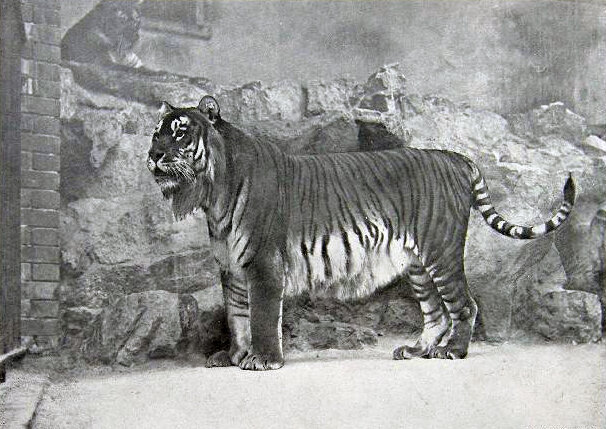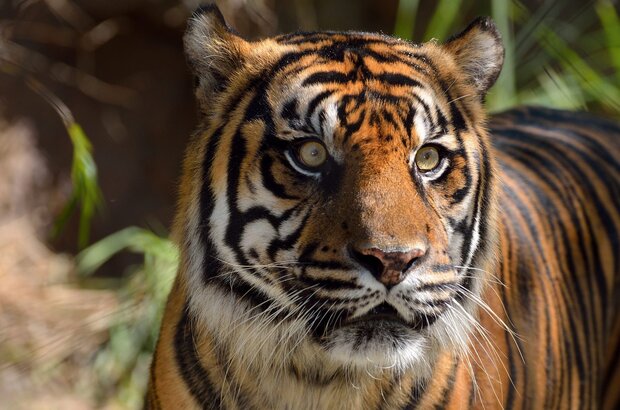Once the tigers were predicted to soon become extinct in the world if effective conservation measures are not deployed, July 29 was observed as a day dedicated to awareness and support worldwide to conserve the tigers whose population dropped dramatically to less than 4,000 individuals in the wild.
Caspian tiger’s roar has not been heard for years
Once upon a time, the Caspian tiger (Panthera tigris virgata) ranged from eastern Turkey through the southern Caspian region of northern Iran to the forested areas in Afghanistan, and northwestern China.
Since the beginning of 19th century, the Caspian tiger was rapidly losing ground to humankind, thus it was deprived of its habitat and prey and soon became a beast in its own territory, so conflicts started to hunt them down as a menace to human settlements.
Therefore, in the mid-20th century, their population whose genetic roots spanned over a million years started to shrink sharply, and finally vanished by the 1950s.
Although, there are reports of the last remaining Caspian tiger which was shot in Golestan National Park in 1953, five years later, some claimed that a tiger has been spotted in Golestan area.
The Department of Environment’s experts have tried to find evidence of Caspian tiger existence searching their previous habitats for several years in the early 1970s, but not a single sign has been found.
Caspian tigers had been protected since 1957, with heavy fines for shooting, but it was too late for the majestic cat to make a recovery. Excessive hunting, poaching, habitat fragmentation, food shortages, poisoning and trapping wiped out the valuable species.

Initial attempts to bring back formidable tigers
In the Iranian calendar year 1389 (March 2009- March 2010), two Siberian tigers were sent to Iran from Russia in exchange of two Persian Leopards; aiming to restore the Caspian tiger generation in the country, but after a while the male one died due to an outbreak of glanders (an infectious disease occurs primarily by ingestion of contaminated food or water).
The female tiger was quarantined for five years on the charge of being infected with the virus, but with the help of wildlife enthusiasts and the DOE after undergoing several medical tests, the animal was then moved to a suitable place in Tehran Zoo.
DNA tests added a spark of hope to the sad story
Although, 8 subspecies of tigers have been identified, in 2004 scientists revised the known classification to five subspecies from those previously identified, as they had been from a genetic standpoint that were separated by humans after years.
Lately, researchers and studies proposed that restoring the lost cats is possible, as the Siberian or Amur tiger show genetic kinship to the Caspian, because they once ruled from Caspian Sea's south shore to the forest areas of China and Korea, north to the forested edges of Siberia, while human cleaved their territory in two, separating the Caspian tiger from the Siberian.
But the question come up that whether the current nature of Iran has the capacity to accept and remain such an enormous species? And is it possible to revive a species which once gone extinct in the same region?
How Caspian tiger faded away in Iran?
Kaveh Feizollahi, a zoologist and an expert in the field of tigers, told IRNA that “tigers are flexible species which can adopt to a wide range of habitat and climate conditions, from the tropical regions of Asia to the ever-snowy areas of Siberia.
On the other hand, their reproductive rate is relatively high and the gap between the regenerations is short; it can change its hunting technique depending on the prey and habitat. However, some of its features have made it vulnerable to human development in West Asia.
The first feature of tigers which caused them to disappear was tiger's dependence on the water resources and its presence near river basins, lake edges and sea shores, where the highest concentration of human population exists and the conflicts pushed them toward extinction.
The second one is related to the prey, the natural prey they mainly fed on was deer, and they attracted to northern Iran probably because of the good population of red deer and roe deer.
However, with population of deer declined, the tiger was inevitably feeding on the wild boar, which has severe population fluctuations and is a temporary source of food.
The third item is hunting, tiger hunting intensified during their final periods living in Iran, due to the reduction of prey and hunting livestock.
Tiger cubs were also captured for illegal trade, in addition, land use changes, superstitions and using their organs in traditional medicine were among the other factors eradicated tigers.”
Is it possible to bring back the vanished Caspian tiger?
Feizollahi went on to say that “the word "possibility" is usually used in two distinct meanings; if the word means the possibility of a theoretical and scientific idea in an ideal setting, then the answer is yes.
But it is very unlikely, as it is used in its daily sense, according to the records and conditions of the country's wildlife.
Assuming that the word "possibility" has been used in the first sense, it should be said that before any such project is started, a feasibility study must first be prepared. However, such a report was not prepared till December 2010, when the DOE representatives went to St. Petersburg to attend the international tiger conservation forum.”
“Certainly, there is no proper habitat for tiger in Iran. If there are intentions to revive the tiger population in Iran, or, in other words, to ensure a stable population of it, a natural habitat must be prepared, including, good vegetation cover, clean water and enough bait.
Before restoring the Caspian tiger in the country, other species of red and roe deer must be increased; for example, 20 tigers in a hypothetical area may need a population of 10,000 large mammals, which may take several years to expand.
After that, the tigers must gradually enter the prepared area; If there is no wild tiger, the tigers kept in captivity should be used as a parent and re-wild their cubs.
The whole process is very difficult, costly, and time consuming.
What the DOE did, the transfer of two Siberian tigers from a Russia to a wildlife park in Iran has nothing to do with a conservation program,” he explained.
He went on to add that to start conservation process, one should initially notice the reason behind Caspian tiger reintroduction in Iran; merely restoring an extinct species out of curiosity or enthusiasm toward history, or using a flag species to attract people's attention and support, while playing the international role of Iran in protecting global biodiversity.
Why conservation of tigers is important?
“In fact, saving the tiger from extinction and maintaining its habitat is the biggest concern of the international community for the conservation of biodiversity, because if we cannot save a precious and flexible specie like tiger from extinction, there is no hope to save the more unknown species that do not attract attention, and the world will be depopulated of animals.
According to an article released in 2010, the cost of protecting each wild tiger was estimated at $10,000 per year, while the price of a tiger skin on the smuggling market is twice that.
This will require an annual budget of $40 million to protect tigers in the world. One of the conservation activists pointed out that the budget in global economy is less than a drop of water,” he concluded.
MNA/TT























Your Comment